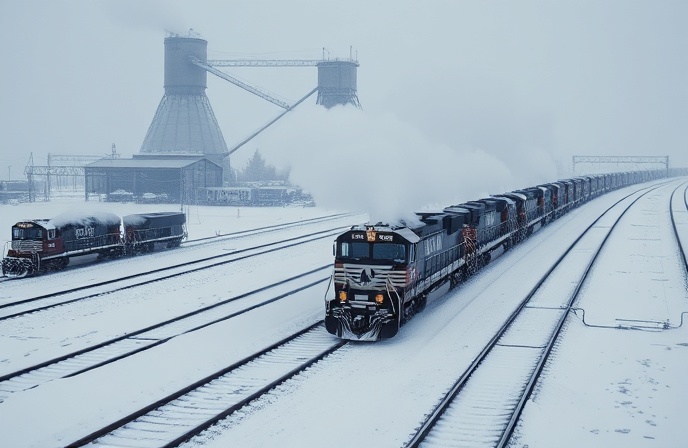Phoenix Mega-Hub: Rail Revolutionizing SW Freight

The burgeoning growth of the Southwestern United States, particularly Arizona, necessitates significant improvements in freight transportation infrastructure. This article explores the strategic development of a massive new rail logistics hub by BNSF Railway (Burlington Northern Santa Fe Railway) in Phoenix, Arizona, highlighting its potential impact on regional transportation efficiency, economic growth, and environmental sustainability. The project encompasses a substantial land area, incorporating intermodal facilities, logistics parks, and distribution centers strategically integrated with existing and planned rail networks. This ambitious undertaking represents a substantial investment reflecting the railroad’s commitment to meeting evolving market demands and supporting sustainable growth in the region. The following sections will delve into the design, functionality, economic implications, and environmental benefits of this significant infrastructure development.
The Phoenix Logistics Hub: Design and Functionality
BNSF’s new Phoenix logistics hub, spanning 4,321 acres in Maricopa County, is a strategically planned complex designed to streamline freight transport in the Southwest. The hub’s three key components are: a 1,770-acre intermodal facility (handling the transfer of freight between rail and road transport), a 1,420-acre logistics park offering warehousing and distribution services, and a 1,131-acre logistics center providing additional storage and handling capabilities. This integrated approach ensures seamless movement of goods, minimizing handling and transit times. Direct rail connections to each section optimize efficiency, reducing reliance on over-the-road trucking for shorter distances. The facility’s design incorporates best practices in rail yard layout, material handling, and security, optimizing operational flow and safety.
Economic Impact and Regional Development
The construction and operation of the Phoenix hub will generate substantial economic benefits. Construction itself creates jobs in construction, engineering, and related industries. The facility’s operation will require a significant workforce, including skilled operators, maintenance personnel, and administrative staff. Furthermore, the improved rail infrastructure will attract new businesses and industries to the region, further stimulating economic growth. The streamlined logistics will allow businesses to reduce their transportation costs and improve supply chain efficiency, enhancing their competitiveness in the broader market. The increased capacity will accommodate future growth, positioning Arizona as a key logistics and distribution center in the Southwest.
Environmental Sustainability and Emission Reductions
A key driver behind the project is its potential to reduce greenhouse gas emissions. By providing an efficient intermodal transfer point, the hub significantly reduces the reliance on long-haul trucking. Rail transport is considerably more fuel-efficient per ton-mile than trucking, leading to a substantial decrease in carbon emissions. The project’s potential for emissions reduction aligns with BNSF’s broader commitment to environmental sustainability and supports broader efforts to decarbonize the transportation sector. The reduction in truck traffic will also decrease noise pollution and improve air quality in the surrounding areas. Furthermore, the facility’s design may incorporate sustainable building practices and energy-efficient technologies to further minimize its environmental impact.
Strategic Significance and Future Outlook
BNSF’s investment in the Phoenix logistics hub underscores the growing importance of rail freight in the Southwestern US. The project demonstrates the company’s proactive approach to meeting evolving market demands and adapting to shifting supply chain dynamics. The location in Phoenix is strategically chosen, given the region’s expanding population and industrial growth. The hub’s success will depend on effective collaboration between BNSF, its customers, and local authorities. Continued investment in rail infrastructure is crucial to support the region’s economic growth and sustainability goals. The project’s success serves as a model for similar investments in other high-growth regions across the nation.
Conclusions
BNSF’s development of the massive Phoenix logistics hub represents a significant advancement in Southwestern US freight transportation infrastructure. The integrated design, encompassing intermodal facilities, logistics parks, and distribution centers, promises to significantly improve efficiency, reduce transportation costs, and enhance regional competitiveness. The project’s economic impact is substantial, generating jobs during construction and operation, attracting new businesses, and fostering economic growth. Moreover, the hub’s strategic focus on reducing reliance on trucking translates to significant environmental benefits, lowering greenhouse gas emissions and improving air quality. The success of this initiative highlights the vital role of rail in supporting sustainable economic growth and the importance of continued investment in rail infrastructure. The Phoenix hub serves as a model for future logistics developments, demonstrating the potential of integrated rail solutions to address the challenges of efficient and environmentally responsible freight transportation in a rapidly expanding region. The long-term effects of this development will contribute significantly to the economic prosperity and environmental sustainability of Arizona and the wider Southwest. The integration of the various components of the logistics hub, from the intermodal facility to the warehousing and distribution centers, ensures a smooth and efficient flow of goods, further bolstering its economic and environmental benefits. The ongoing commitment by BNSF to sustainable practices within the design and operation of the hub reinforces its position as a leader in environmentally responsible rail transportation.






